
Rutidosis leptorrhynchoides, commonly known as button wrinklewort, is a flowering plant in the family Asteraceae. It is an upright, tufted, perennial herb with bright green leaves and yellow button-shaped flowers.

Acrotriche depressa, commonly known as wiry ground-berry or honeypots, is a flowering plant in the family Ericaceae. It is a small shrub with crowded greyish-green leaves and white or green flowers and grows in southern Australia.

Pterocaulon sphacelatum, commonly known as apple bush or fruit-salad plant, is a species of flowering plant in the family Asteraceae. It is an upright shrub with mostly pink to purple flowers and is endemic to Australia.

Scaevola ramosissima, commonly known as the purple fan-flower or snake flower is a flowering plant in the family Goodeniaceae and is endemic to south eastern Australia. It has wiry, horizontal branches and purple fan-shaped flowers.
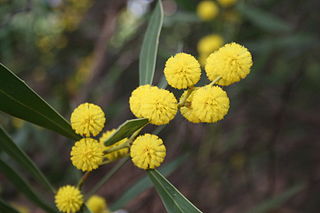
Acacia beckleri commonly known as Barrier Range wattle, is a flowering plant in the family Acacia. It is an upright or spreading shrub with green or bluish-green leaves and yellow ball flowers.

Poranthera microphylla, commonly known as small poranthera, is a flowering plant in the family Phyllanthaceae. It is a small, widespread Australian herb with blue-grey leaves and white flowers.
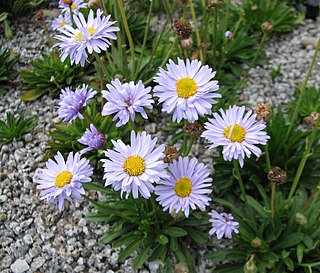
Brachyscome scapigera commonly known as tufted daisy,is a flowering, perennial herb in the family Asteraceae. It has white or mauve daisy-like flowers and is endemic to south-eastern Australia.

Brachyscome dentata, commonly known as lobe-seed daisy, is a tufted perennial herb in the family Asteraceae and is endemic to Australia. It has mostly white or mauve daisy-like flowers, a yellow centre and pale green leaves. It is endemic to Australia.
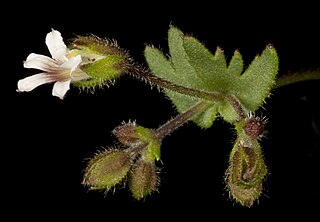
Goodenia cycnopotamica is a species of flowering plant in the Goodeniaceae family and is endemic to Australia, found in both South Australia and Western Australia. It is an annual herb with oblong to lance-shaped leaves and pink or lilac to white flowers.
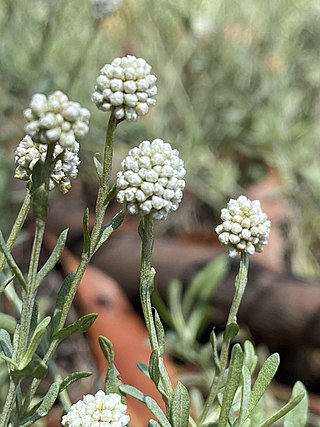
Calocephalus lacteus, commonly known as milky beauty-heads, is a species of flowering plant in the family Asteraceae. It is an ascending, spreading perennial with silver-grey leaves and cream globular-shaped flower heads. It occurs in eastern Australia.
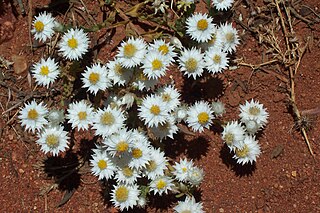
Rhodanthe floribunda, commonly known as common white sunray, is a flowering, herbaceous plant in the family Asteraceae. It is a small, upright or decumbent plant with white flowers, yellow florets and is endemic to Australia.

Calotis lappulacea, commonly known as the yellow burr-daisy, is a flowering plant in the family Asteraceae found in many parts of mainland Australia. It is a small, perennial herb with yellow globular flower-heads.
Gentiana wingecarribiensis is a flowering plant in the family Gentianaceae and is endemic to New South Wales. It is a small, upright or decumbent annual herb with blue to mauve flowers.

Scaevola anchusifolia commonly known as silky scaevola, is a species of flowering plant in the family Goodeniaceae. It is a small, upright or decumbent shrub with fan-shaped blue to bluish white flowers and is endemic to Western Australia.

Minuria leptophylla commonly known as minnie daisy, is a flowering plant in the family Asteraceae. It is a small perennial herb with white daisy-like flowers. It is endemic to Australia and grows in all mainland states.
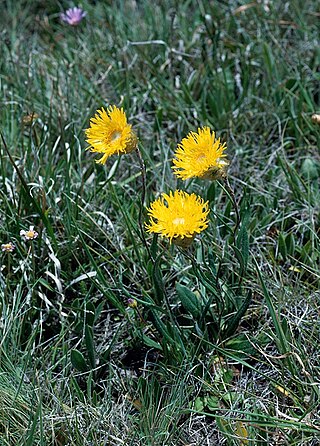
Podolepis decipiens, commonly known as deceiving copperwire-daisy, is a flowering plant in the family Asteraceae and grows in Victoria, Tasmania and New South Wales. It is an upright, perennial herb with yellow daisy-like flowers on a single stem rising from a sparse rosette.

Calocephalus lacteus, commonly known as lemon beauty-heads, is a species of flowering plant in the family Asteraceae. It has yellow cylindrical shaped flowers and grey stems and grows in the eastern states of Australia

Calocephalus platycephalus commonly known as western beauty-heads or yellow top, is a species of flowering plant in the family Asteraceae. It is an upright to sprawling herb with white hairy branches and yellow ball-shaped flower heads and is endemic to Australia.

Calocephalus francisii, commonly known as fine-leaf beauty-heads, is a species of flowering plant in the family Asteraceae. It is a small annual with yellow globular-shape flowers and is endemic to Western Australia.

Leptorhynchos tenuifolius, commonly known as wiry buttons, is a species of flowering plant in the family Asteraceae. It is an upright to ascending herb, multi-branched and has yellow flowers and grows in Victoria and South Australia.




















